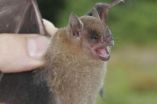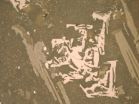(Press-News.org) Monday night's lunar eclipse proved just as delightful as expected to those able to view it. On the East Coast, cloudy skies may have gotten in the way, but at the National Science Foundation's National Optical Astronomy Observatory (NOAO) near Tucson, Ariz., the skies offered impressive viewing, as seen from the pictures provided here.
Nicknamed a "blood moon," this lunar eclipse's color was similar to the majority of lunar eclipses. This has to do with the Earth's atmosphere's propensity for longer-wavelength light (e.g., the reds, oranges and yellows seen in sunrises and sunsets). However, according to NOAO Astronomer Stephen Pompea, the lunar eclipse's hue means more than just a pretty moon.
"The study of the color of lunar eclipses can be used to understand dust in the stratosphere including the amount and particle size of dust injected by volcanic eruptions," he said. "Understanding the amount of dust can help scientists create better models of climate change."
For those who missed this lunar eclipse, fear not. Three more are to occur fairly soon: Oct. 8, 2014; April 4, 2015 and Sept. 27, 2015.
INFORMATION:
Red moon at night; stargazer's delight
NOAO offers front-row seat to lunar eclipse
2014-04-16
ELSE PRESS RELEASES FROM THIS DATE:
Information storage for the next generation of plastic computers
2014-04-16
Inexpensive computers, cell phones and other systems that substitute flexible plastic for silicon chips may be one step closer to reality, thanks to research published on April 16 in the journal Nature Communications.
The paper describes a new proposal by University of Iowa researchers and their colleagues at New York University for overcoming a major obstacle to the development of such plastic devices—the large amount of energy required to read stored information.
Although it is relatively cheap and easy to encode information in light for fiber optic transmission, ...
Two new species of yellow-shouldered bats endemic to the Neotropics
2014-04-16
Lying forgotten in museum collections two new species of yellow-shouldered bats have been unearthed by scientists at the American Museum of New York and The Field Museum of Natural History and described in the open access journal ZooKeys. These two new additions to the genus Sturnira are part of a recent discovery of three bats hidden away in collections around the world, the third one still waiting to be officially announced.
Up until recently the genus Sturnira was believed to contain only 14 species. In the last years closer morphological and molecular analysis have ...
Researchers: Obesity can amplify bone and muscle loss
2014-04-16
TALLAHASSEE, Fla. – Florida State University researchers have identified a new syndrome called "osteosarcopenic obesity" that links the deterioration of bone density and muscle mass with obesity.
"It used to be the thinking that the heavier you were the better your bones would be because the bones were supporting more weight," said Jasminka Ilich-Ernst, the Hazel Stiebeling Professor of Nutrition at Florida State. "But, that's only true to a certain extent."
The syndrome, outlined in the May issue of Ageing Research Reviews, explains how many obese individuals experience ...
Researchers develop a new drug to combat the measles
2014-04-16
A novel antiviral drug may protect people infected with the measles from getting sick and prevent them from spreading the virus to others, an international team of researchers says.
Scientists from the Institute for Biomedical Sciences at Georgia State University, the Emory Institute for Drug Development and the Paul-Ehrlich Institute in Germany developed the drug and tested it in animals infected with a virus closely related to one that causes the measles. As reported in the current issue of the journal Science Translational Medicine, virus levels were significantly ...
Celldex's Phase 1 study of CDX-1401 published in Science Translational Medicine
2014-04-16
HAMPTON, NJ (April 16, 2014): Celldex Therapeutics, Inc. (NASDAQ: CLDX) announced today that final data from its Phase 1 study of CDX-1401 in solid tumors, including long-term patient follow-up, have been published in Science Translational Medicine (Vol 6 Issue 232). The data demonstrate robust antibody and T cell responses and evidence of clinical benefit in patients with very advanced cancers and suggest that CDX-1401 may predispose patients to better outcomes on subsequent therapy with checkpoint inhibitors. CDX-1401 is an off-the-shelf vaccine consisting of a fully ...
Meteorites yield clues to red planet's early atmosphere
2014-04-16
Geologists who analyzed 40 meteorites that fell to Earth from Mars unlocked secrets of the Martian atmosphere hidden in the chemical signatures of these ancient rocks. Their study, published April 17 in the journal Nature, shows that the atmospheres of Mars and Earth diverged in important ways very early in the 4.6 billion year evolution of our solar system.
The results will help guide researchers' next steps in understanding whether life exists, or has ever existed, on Mars and how water—now absent from the Martian surface—flowed there in the past.
Heather Franz, ...
Mutant protein in muscle linked to neuromuscular disorder
2014-04-16
Sometimes known as Kennedy's disease, spinal and bulbar muscular atrophy (SBMA) is a rare inherited neuromuscular disorder characterized by slowly progressive muscle weakness and atrophy. Researchers have long considered it to be essentially an affliction of primary motor neurons – the cells in the spinal cord and brainstem that control muscle movement.
But in a new study published in the April 16, 2014 online issue of Neuron, a team of scientists at the University of California, San Diego School of Medicine say novel mouse studies indicate that mutant protein levels ...
Study provides crucial new information about how the ice ages came about
2014-04-16
An international team of scientists has discovered new relationships between deep-sea temperature and ice-volume changes to provide crucial new information about how the ice ages came about.
Researchers from the University of Southampton, the National Oceanography Centre and the Australian National University developed a new method for determining sea-level and deep-sea temperature variability over the past 5.3 million years. It provides new insight into the climatic relationships that caused the development of major ice-age cycles during the past two million years.
The ...
Searching for dark energy with neutrons
2014-04-16
All the particles we know to exist make up only about five per cent of the mass and energy of the universe. The rest – "Dark Matter" and "Dark Energy" – remains mysterious. A European collaboration lled by researchers from the Vienna University of Technology has now carried out extremely sensitive measurements of gravitational effects at very small distances at the Institut Laue-Langevin (ILL) in Grenoble. These experiments provide limits for possible new particles or fundamental forces, which are a hundred thousand times more restrictive than previous estimations.
Undiscovered ...
Ancient shark fossil reveals new insights into jaw evolution
2014-04-16
The skull of a newly discovered 325-million-year-old shark-like species suggests that early cartilaginous and bony fishes have more to tell us about the early evolution of jawed vertebrates—including humans—than do modern sharks, as was previously thought. The new study, led by scientists at the American Museum of Natural History, shows that living sharks are actually quite advanced in evolutionary terms, despite having retained their basic "sharkiness" over millions of years. The research is published today in the journal Nature.
"Sharks are traditionally thought to ...
LAST 30 PRESS RELEASES:
Numbers in our sights affect how we perceive space
SIMJ announces global collaborative book project in commemoration of its 75th anniversary
Air pollution exposure and birth weight
Obstructive sleep apnea risk and mental health conditions among older adults
How talking slows eye movements behind the wheel
The Ceramic Society of Japan’s Oxoate Ceramics Research Association launches new international book project
Heart-brain connection: international study reveals the role of the vagus nerve in keeping the heart young
Researchers identify Rb1 as a predictive biomarker for a new therapeutic strategy in some breast cancers
Survey reveals ethical gaps slowing AI adoption in pediatric surgery
Stimulant ADHD medications work differently than thought
AI overestimates how smart people are, according to HSE economists
HSE researchers create genome-wide map of quadruplexes
Scientists boost cell "powerhouses" to burn more calories
Automatic label checking: The missing step in making reliable medical AI
Low daily alcohol intake linked to 50% heightened mouth cancer risk in India
American Meteorological Society announces Rick Spinrad as 2026 President-Elect
Biomass-based carbon capture spotlighted in newly released global climate webinar recording
Illuminating invisible nano pollutants: advanced bioimaging tracks the full journey of emerging nanoscale contaminants in living systems
How does age affect recovery from spinal cord injury?
Novel AI tool offers prognosis for patients with head and neck cancer
Fathers’ microplastic exposure tied to their children’s metabolic problems
Research validates laboratory model for studying high-grade serous ovarian cancer
SIR 2026 delivers transformative breakthroughs in minimally invasive medicine to improve patient care
Stem Cell Reports most downloaded papers of 2025 highlight the breadth and impact of stem cell research
Oxford-led study estimates NHS spends around 3% of its primary and secondary care budget on the health impacts of heat and cold in England
A researcher’s long quest leads to a smart composite breakthrough
Urban wild bees act as “microbial sensors” of city health.
New study finds where you live affects recovery after a hip fracture
Forecasting the impact of fully automated vehicle adoption on US road traffic injuries
Alcohol-related hospitalizations from 2016 to 2022
[Press-News.org] Red moon at night; stargazer's delightNOAO offers front-row seat to lunar eclipse








